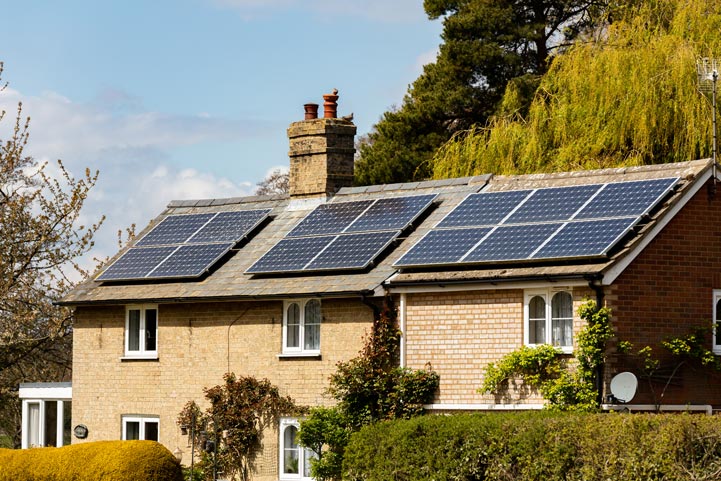Minimum energy efficiency standards will be a moving target. How can landlords remain compliant in the long term?
Improving the energy efficiency of homes is a national priority, it is essential for the UK to achieve net zero homes because 17% of UK emissions come from residential property. To cut the carbon footprint of the private rented sector in England and Wales, a September 2020 consultation proposed amending the minimum energy efficiency standard (MEES) regulations to raise the minimum energy performance certificate (EPC) level required to band C for new tenancies from 2025 and for all tenancies from 2028. Alongside this, the amount landlords are obliged to spend before qualifying for an exemption would increase from a cost cap of £3,500 per property to £10,000 per property. A significant increase for landlords to sustain, particularly if the expenditure has to be repeated each time the EPC target is lifted or an exemption expires. Change is also planned for Scotland, where the government is aiming to introduce regulations in 2025 that would mirror the targets and timeframe proposed for England and Wales.
Adoption of these proposals in England and Wales had become the working assumption, but as time passes, the proposed timescales have become increasingly implausible. Since the consultation, the government has not formally confirmed its policy intentions, but in a recent interview on BBC Radio 4’s Today programme, Michael Gove, the secretary of state for levelling up, housing and communities, suggested the proposals will be revised and implementation delayed. In parliament, the government has committed to respond to the 2020 consultation before the end of 2023, but implied this would simply summarise the responses rather than announce its policy intentions. Our understanding is that the Department for Energy Security and Net Zero has indicated that the first implementation date will no longer be 2025 and that the EPC assessment process itself will be reviewed, but there has been no formal announcement to this effect.

What action should landlords take?
While the milestones may be uncertain, landlords can be certain that energy efficiency will be a policy priority. The Labour Party has stated that its policies will include a national Warm Homes Plan to upgrade all homes to EPC band C within a decade.
Knowing the compliance baseline will continue to rise, there is a strong argument for landlords developing an energy efficiency strategy focused on the big picture rather than the next EPC target. Many have set their own net zero objectives and merely complying with the MEES regulations will not meet these nor achieve them in the most cost-effective way possible. By analysing and modelling their portfolios strategically, landlords can ensure both compliance with MEES and progress towards achieving net zero.
There is a strong argument for landlords developing an energy efficiency strategy focused on the big picture of net zero rather than the next EPC target
Katie Stein, Associate Director, Rural Research
The EPC can make impractical suggestions or steer short-term thinking because it takes a general approach to all property. These weaknesses have been acknowledged, and a new consultation in Scotland seeks to reform domestic and non-domestic EPCs to increase the importance placed on the building fabric and carbon emissions of the heating source. At present, an EPC will always suggest boiler upgrades using a like-for-like fuel source, whereas a net zero-focused energy efficiency strategy would review the suitability of alternative heating technologies to minimise carbon emissions going forward.
Given substantial capital investment is likely to be required, landlords will want to ensure that their investment delivers against multiple objectives. As well as compliance and cost efficiency, elements such as heat security, environmental performance and quality of life for tenants can be built into the energy efficiency strategy to ensure investment is well targeted.
Creating an energy efficiency strategy
1 Assess
A building surveyor’s assessment provides a more comprehensive appraisal of a building than an EPC, which is based on limited observations, assumptions and measurements. A building surveyor will conduct more invasive investigations to establish the property’s true condition and capacity for appropriate upgrades. Where an EPC assessment may make a cavity wall insulation recommendation, a building survey could determine a wall’s external face is not watertight, making such insulation unsuitable and potentially problematic.
Taking a more detailed and holistic approach means other objectives can also be met. For example, health and safety upgrades identified or a preventative maintenance programme developed to plan and manage expenditure. While this may add time and cost, the process is more efficient overall and can provide a thorough understanding of each building and its potential within a portfolio.
2 Analyse
The information gathered can then be analysed and multiple scenarios developed. Typically, three are put forward:
- Compliance The necessary base measures to make the property legally lettable. As well as minimum energy efficiency standards, other factors such as health and safety and property condition can be reported.
- Best achievable What is the realistic best-case scenario? Crucially, these recommendations are based on the building surveyor’s property-specific assessment.
- Recommended A balanced approach incorporating budget, the value of the asset and the individual objectives of the landlord. It also considers the significance of the building – for example, is it a heritage or core property?
Compliance is essential in all scenarios, so once a decision is made the Standard Assessment Procedure is conducted to understand what EPC rating would be achieved.
3 Combine
Conducting an assessment of all properties in a portfolio provides an initial, estate-wide benchmark to establish the current position, overall recommended actions and the ultimate potential of the portfolio, including potential emissions savings, EPC ratings, percentage improvement and the estimated costs to achieve the target. Beyond this, it is possible to calculate how much carbon offsetting may be needed to achieve net zero if that is the overall goal.
Collating all this information in one place allows scenarios to be modelled and the impact on compliance levels, energy costs, greenhouse gas emissions and investment requirements to be understood.
4 Comply
MEES compliance must nonetheless be addressed. A professional energy assessor who is aware of the nuances of different properties can be invaluable. Providing the acquired knowledge to that assessor can help ensure that EPCs are informed by evidence and fewer assumptions. If achieving the EPC target is not possible in the short or longer term, exemptions may be available, supported by evidence gathered during the portfolio review.

FUTURE-PROOFING RURAL HOMES
The Church of England has committed to achieving net zero carbon by 2030 and must address emissions from buildings as part of its strategy. By the end of 2023, all dioceses are required to have retrofitting and maintenance plans in place and to have commissioned stock surveys such as EPC Plus reports for clergy housing. By 2024, all will have stock improvement plans in place.
The Diocese of Truro intends to bring as many retained properties up to EPC band A as possible, while upgrading all others to a high standard where this is not possible. Following an enhanced EPC process, two-thirds of its property is expected to achieve band A and all but a small proportion of the remainder will achieve band B. When initial assessments were conducted, two-thirds of the retained properties sat at band D or below, marking a vast improvement in energy efficiency that is far beyond current compliance requirements but essential for its longer-term goal.
On average, upgrades will cost in excess of £32,000 per property, with the investment in some costing up to £75,000. Yet this will see 96% of properties equipped with solar photovoltaics and 61% fitted with air-source heat pumps. In addition to compliance, the approach is designed to create heat security, with wood burners also being installed in certain cases, and significant reductions in greenhouse gas emissions. Front-loading capital investment future-proofs the portfolio, allowing the retention of a valuable and resilient asset for the long term.
In addition to compliance, the approach is designed to create heat security, with wood burners also being installed in certain cases and significant reductions in greenhouse gas emissions. Heat security is just one consideration to ensure residents are comfortable and the properties represent desirable and affordable living spaces. The satisfaction and involvement of the resident in each property is seen as essential, both in achieving net zero goals and creating appealing living spaces.
Read the articles within Spotlight: The future of rural homes below.
.jpg)
